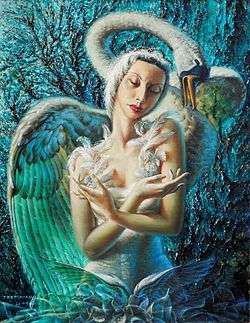Alicia Markova "The Dying Swan"
 | |
| Artist | Vladimir Tretchikoff |
|---|---|
| Year | 1949 |
| Medium | Oil on canvas |
| Dimensions | 92 cm × 72 cm (36 in × 28.5 in) |
Alicia Markova "The Dying Swan" (also known as The Dying Swan, but not to be confused with another painting with the same title by the same artist started in 1949 and completed in 1951) is a painting by Vladimir Tretchikoff painted in 1949. In this portrait fantasy, Tretchikoff has identified the prima ballerina Alicia Markova[1] in her most famous role - The Dying Swan - from which, as did Anna Pavlova, she has become inseparable in the minds of all lovers of the ballet; it is for this reason that the artist painted the swan and Markova as one and the same being.[2]
Historical background
Extract from Tretchikoff's Autobiography Pigeon's Luck:[3]
The Schlesinger organisation was sponsoring a tour of South Africa by the Royal Ballet from London, with its principals Alicia Markova and her partner, Anton Dolin. When I returned to Cape Town Natalie[4] and I went to see them dance, and I was so intrigued that I went to see them rehearse. I was sitting in the stalls with a friend nicknamed Silver Fox from his pure white shock of hair. Markova was dancing the Dying Swan in 'Swan Lake' and I found the experience moved me deeply.
'I want to paint her,' I told Silver Fox.
'Why don't you ask her manager? He's sitting next to us.'
When the rehearsal was over Silver Fox introduced me to Markova's manager, and told him of my idea. He did not look enthusiastic.
'Not a chance,' he said. 'There's no time.'
'If anyone can paint Alicia this is your man,' he said earnestly. 'He'll make it something special.'
The manager hardly stirred.
'Got anything to show me?' he asked, obviously bored stiff by the whole idea.
'Not here,' I said. 'But my studio's just around the corner from your hotel. If you have a few minutes to spare I'll come and fetch you.'
'Okay. I'll give you five minutes tomorrow morning. Pick me up at nine sharp.'
At the studio the next morning he looked through my paintings, and it amused me to find that this
hard-headed American so long immersed in the cut-and-thrust of show business was not indifferent to
them. In fact, he stayed all morning.
'All right,' he said at last. 'You've convinced me. Now let's see what Alicia has to say.'
She liked the paintings too. But when I told her I wanted to paint her as she appeared in 'Swan Lake', she sadly shook her head.
'No time at all,' she said. 'When could we do it? In the mornings I rehearse and in the evenings we perform.'
'I'd be prepared to fall in with your arrangements,' I said. 'Fit in an hour here, an hour there. I'll follow you round the country if need be.'
She laughed.
'All right,' she said. 'You're on. I'll give you all my free time - but there's not all that much of it, I'd better warn you now.'
I began work as soon as possible. First I had to paint the background, and with it the outline of the Dying Swan itself to balance the ballerina. By the time it was ready the ballet had moved on to Johannesburg and I had to pack my bags and follow them. I checked in at the Carlton.[5]
There was a problem in that in Johannesburg I had no studio. But that was soon overcome. When the hotel manager heard of the difficulty he gave me the best suite in the hotel at no extra charge, the lightest and airiest in the building and an ideal working space.
My idea in the Dying Swan was to paint Alicia intertwined with the bird she portrayed, the two inseparable in the moment of death, the end of the dance. Alicia was infinitely patient in the long hours of posing and as generous with her free time as she had promised.
Strange as it may seem, Alicia's co-operation had a great influence on the painting. With the ballerina so unselfish I was doing my damnedest to produce my best.
When it was time for the company to move on to Pretoria, I went with them. One evening in Pretoria I went down to see Alicia dance yet again, watching from the wings with no less enthusiasm than I had the first time, when I felt a tap on my shoulder. It was Anton Dolin, Alicia's partner.
'Hello there,' he whispered. 'Back to see the Dance of the Dying Duck?'
He startled me.
'What do you mean?'
'Don't you know? In the business that's the nickname we have for the Dying Swan.
'I've got news for you,' I said. 'You know the swan in the painting? I couldn't get the real thing, so I painted it from a dead duck.'
Notes
References
- Timmins, Howard B, Tretchikoff, South African Edition 1950 with Foreword by Prebble Rayner
- Timmins, Howard B, Tretchikoff, American Edition 1953 with Foreword by Prebble Rayner
- Buncher, Richard, Tretchikoff, published by Howard Timmins with foreword by Stuart Cloete 1969
- Tretchikoff, V & Hocking, A Pigeon's Luck, 1973, ISBN 0-00-211335-X
External links
| Wikiquote has quotations related to: Alicia Markova "The Dying Swan" |